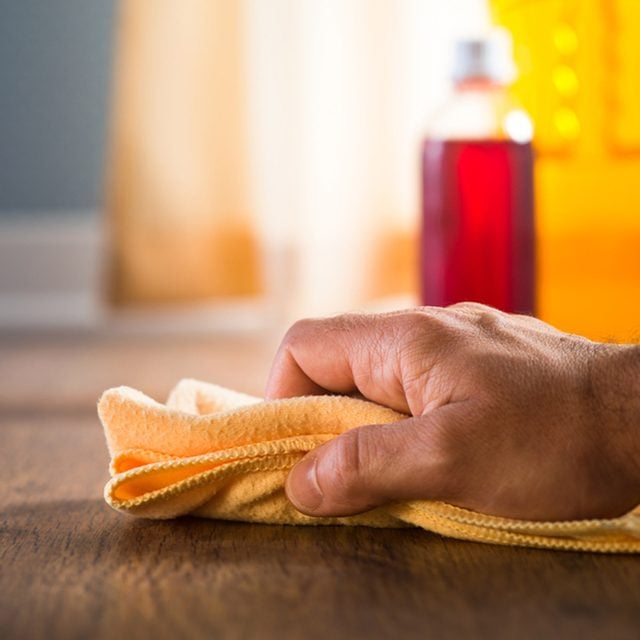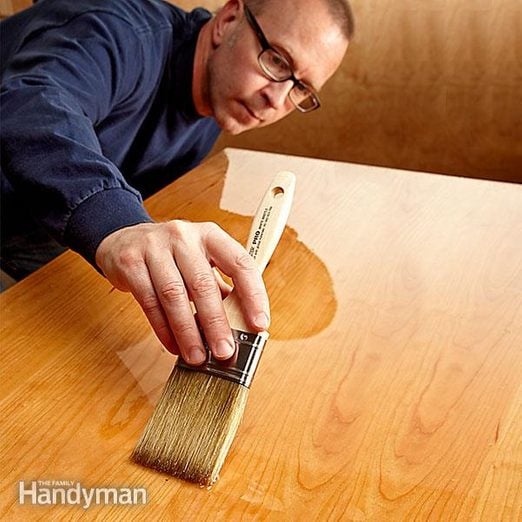How to Stain and Refinish a Table Top
Updated: Apr. 06, 2024
Looking for a glass-smooth wooden table top? Learn how to stain and refinish a table top to bring it back to pristine condition.
3 to 5 hours
Intermediate
Introduction
Finishing a tabletop is tricky. On a big table especially, coating the entire surface before the finish becomes too sticky is the ultimate test of speed and skill. And your work has to be perfect. More than any other furniture surface, a tabletop reflects light and shows off every little flaw. But that doesn't mean you can't do it. These tips will make the tough parts easier and help you achieve a perfect finish.
Nothing ties a dining room together like a beautiful wooden table. But time can take a toll on wood, so whether you’re flipping furniture for a side hustle or just wanting to get your antique table looking glowing again, you may want to refinish it. Want to restore an old wobbly chair? Here is how you can fix it.
Refinishing furniture, especially a tabletop, can be tricky. On a big table especially, coating the entire surface before the finish becomes too sticky is the ultimate test of speed and skill. And your work has to be perfect. More than any other furniture surface, a tabletop reflects light and shows off every little flaw.
But that doesn’t mean you can’t do it. These tips will make the tough parts easier and help you achieve a perfect finish. Follow this guide for finishing a tabletop to flawless perfection.
Project step-by-step (9)
Preparation
Cover the Work Area
- Open rafters and trusses are an endless source of falling dust. So if you’re working under an open ceiling, hang plastic sheeting above.
- Keep the plastic at least 12 inches from light fixtures or remove the bulbs.
- If you’re using oil-based finishes, hang the sheets about a foot from the floor to allow for ventilation.
Wet the Floor
- A floor dampened with a mop or spray bottle has two benefits: It prevents you from kicking up dust as you walk around. And it raises the humidity, so polyurethane dries slower and remains workable longer.
Get the lighting right
- Overhead lighting is great for most shop work, but it’s bad for finishing. Try this instead: Turn off the overhead lights and position a bright light 4 to 5 feet off the floor. The low-angle glare will highlight every flaw.
Remove the table legs
- A disassembled table is much easier to move and the legs are easier to finish. On a typical table, removing each leg is as simple as unscrewing a nut.
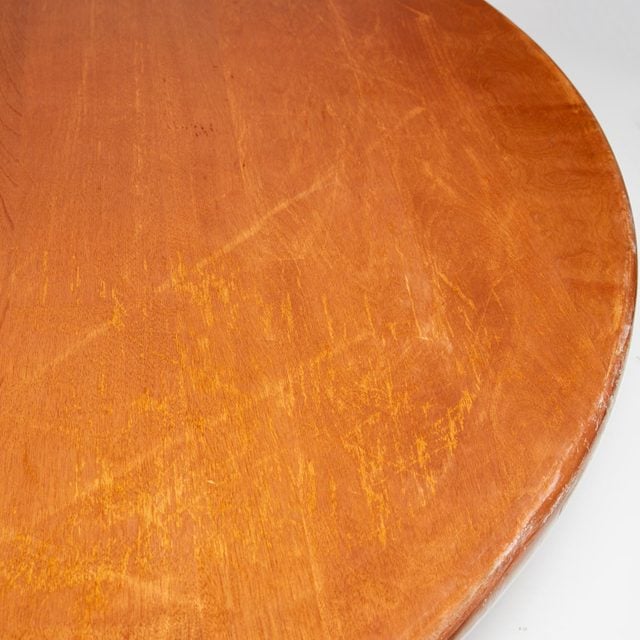
Dust prevention
Airborne dust is the wood finisher’s nemesis. It settles on wet coatings and creates ugly bumps in the dried finish. You can sand them out, but it’s better to minimize that labor by minimizing dust sources.
Clean your work area
- Clean up the work area and change out of the dusty clothes you wore while sanding.
Limit air movement
- If you’re using water-based finishes, control airborne dust by turning off forced-air heating or cooling, and by closing windows and doors.
- This doesn’t apply to oil-based finishes, for which ventilation is required to remove harmful fumes.
Vac and tack
- A vacuum with a brush attachment will remove 99 percent of the sanding dust. But that’s not enough. This photo shows how much dust is left over.
- After vacuuming, wipe with a tack cloth if you plan to use oil-based stain or coatings.
- If you’re using water-based finishes, use a lint-free rag dampened with mineral spirits.
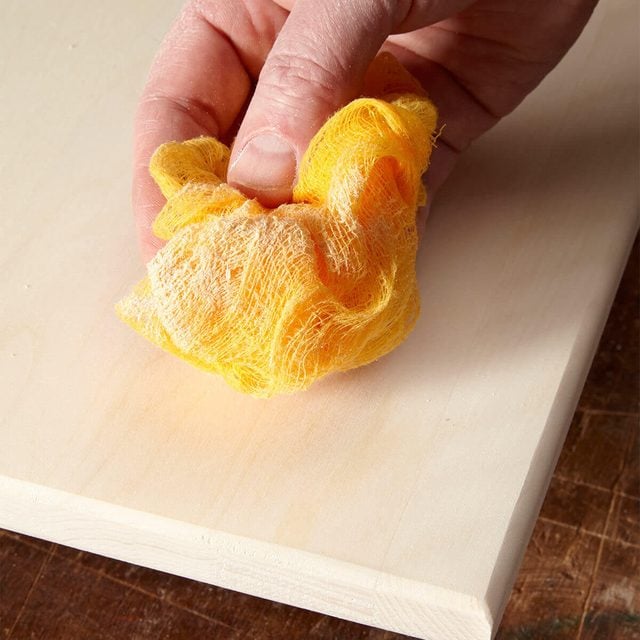
Sanding the wood
There’s no avoiding sanding the table top you’re refinishing; it’s the only way to get the strip the old finish off and get your table smooth enough for staining it. Even if you start with a chemical stripper, you’re still going to have to do some sanding to get the surface of your table even and as smooth as possible. This is a critical step, because any flaw in the sanding will be revealed once you put the stain on it.
Sand every square inch the same
- Any variation in sanding steps can show up in the final finish. If, for example, you run out of 80-grit sandpaper halfway through the initial sanding, you might be tempted to switch to 100-grit. Don’t. Even after sanding with higher grits, the stain may look different in differently treated areas.
Skip grits when sanding
- You don’t have to use every available grit as you progress from coarse to fine. Instead, you can jump from 80-grit to 120- to 180-, skipping 100-and 150-grit.
Don’t over-sand
- Most professionals stop at 150-grit on coarse-grain woods like oak or walnut and 180-grit on fine-grain woods like cherry or maple. But that doesn’t apply to end grain. End grain shows sanding scratches more than face grain, so you may have to sand to 220- or even 320-grit.
Do a final sanding by hand
- A random orbital sander is perfect for most of the sanding. But do a five-minute final sanding by hand using the same grit. Hand-sanding with the grain removes swirls and torn wood fibers left by the orbital action of the sander.
Inspect your sanding work
- To find flaws before you stain, use low-angle light. Wiping on mineral spirits also helps to reveal problems.

Staining the wooden table top
Apply a conditioner before staining
- Most common wood species — pine, birch, maple and cherry — absorb stain unevenly. For a more consistent finish, apply a pre-stain conditioner.
Use polyurethane
There are lots of clear finishes. But for a combination of usability and durability, you can’t beat polyurethane finish.
- Oil-based poly, which dries slower than water-based, is best for beginners because it allows more working time.
- The other important difference is clarity: Water-based poly is absolutely colorless, while oil-based has an amber tone, which can be good or bad depending on the look you want.
Start with high-gloss polyurethane
- A few coats of semigloss or satin polyurethane look like a sheet of dull plastic over the wood. So build up coats of gloss poly first.
- Then, if you want less sheen, dull the finish by wet sanding or wiping on a couple of coats of satin or semigloss.
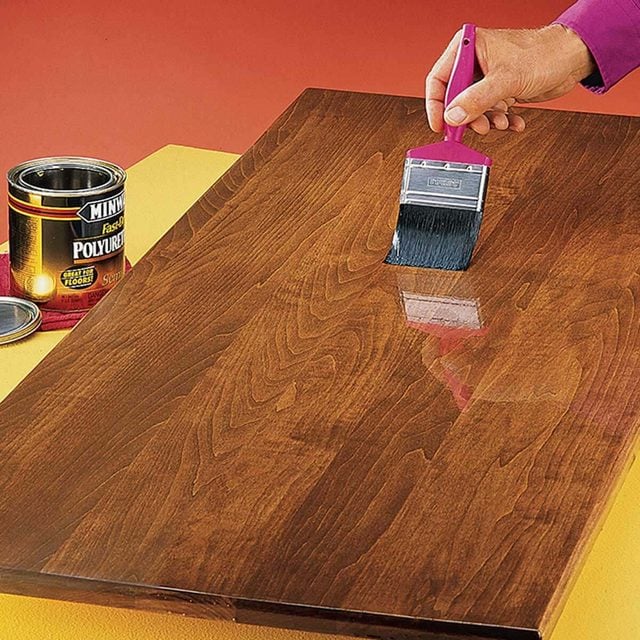
Oil-based vs. water-based polyurethane
Apply water-based poly with a pad
- Water-based poly dries faster than oil, so it’s even harder to brush over a big surface. The solution is a paint pad, which applies polyurethane fast and smooth.
- Just dip the pad into a pan of poly and drag the pad across the surface. Be sure to smooth out any ridges pushed up by the edges of the pad.
Roll on oil-based poly
- Coating a big surface with a brush — before the poly becomes gooey — requires speed and skill. Rolling is faster, easier and almost goof-proof. Rolled-on poly looks terrible at first, but the bubbles disappear in minutes, leaving a smoother surface than most of us can achieve with a brush.
- Beware of ridges formed by the edges of the roller and humps where you start and stop. You can minimize both of those flaws by applying lighter coats. We experimented with several kinds of rollers and got the best results with microfiber mini rollers.
- We also tried rolling on water-based poly; don’t do it.
Work fast
- Depending on the conditions, oil-based poly may become too sticky to work with after just five to ten minutes. Water-based poly dries even faster. So have all your supplies lined up and ready to go before you start. And once you’ve started, there’s no time for coffee or bathroom breaks.
Apply at least three coats of stain
- With a thicker layer of protection, damage to the underlying wood is less likely — so your tabletop will look better longer, and reviving the finish will be easier. Some finishers apply four or even five coats when staining wood.
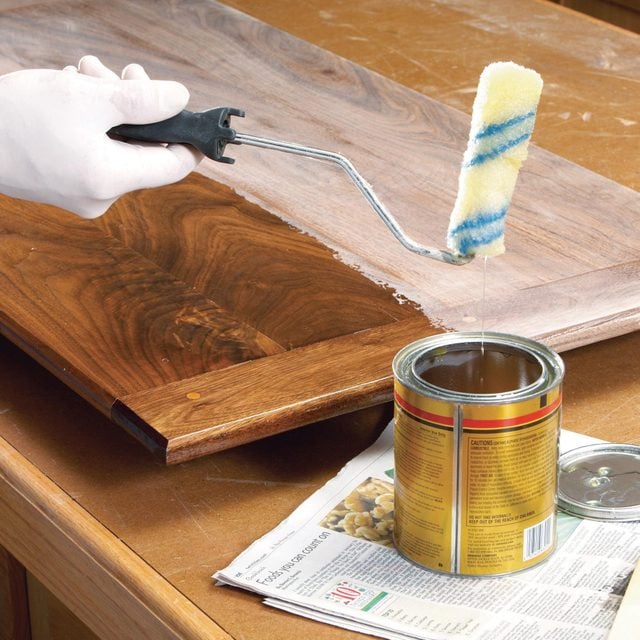
More sanding
Sand between coats
- A quick hand-sanding between coats flattens our flaws before the next coat. Polyurethane tends to gum up sandpaper, so use paper or pads that resists clogging (320-grit).
Wet sand before final coats
- Load a sanding block with 600-grit wet/dry paper, dribble on some soapy water and rub the finish smooth.
- Then wipe the table dry, look for flaws and rub some more.
- Don’t stop until you achieve perfection.
- Smooth shaped edges with synthetic steel wool.
Clean the table top after wet sanding
- As the table dries after wet sanding, a white residue will appear. Be sure to clean it off completely. Residue left in the grain lines of coarse-grain wood will be trapped under the final coat and haunt you forever.
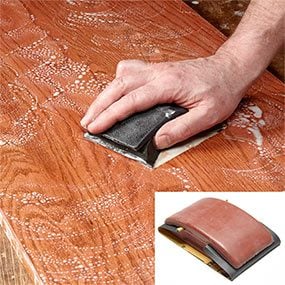
Correcting mistakes
Refinishing a table top isn’t easy, and you will make mistakes. But don’t worry, the most common mistakes people make when staining wood furniture are easily corrected.
Don’t sand through
- If you sand through the polyurethane and remove some stain, you can touch up with more stain. But the repair won’t be perfect, so take pains to avoid that mistake.
- Sand very lightly after the first coat, just enough to remove the dust whiskers.
- After the second coat, you can sand a little harder to flatten larger flaws.
- Always be careful around the edges of the table; that’s where it’s easiest to sand through.
Fill-in the wood grain
- The deep grain lines in woods like oak or walnut will telegraph through the clear finish, no matter how many coats you apply. And that’s fine; it’s part of the character of coarse-grain woods. But if a perfectly smooth surface is the look you want, use a grain filler. You’ll find several products online or at woodworking stores.
- With most, you wipe on the filler, squeegee off the excess with a plastic putty knife and then sand after it’s dry for a smooth-as-glass surface.

Finishing touches
Wipe away the drips
- After the table is completely coated, wrap a rag around your finger and wipe off any drips along the underside.
Wipe on the final coats
- Wet-sanding leaves the surface perfectly smooth but dull. To restore the shine, apply two coats of wipe-on polyurethane (available in gloss, semigloss and satin).
- Wiping results in a very thin, fast-drying coat, so flaws like dust nubs or sags are less likely.
Spray the legs
- Table legs — especially shaped legs — are almost impossible to coat smoothly with a brush. So instead, hang them from the ceiling with wire and spray them.
Coat the underside
- Wood absorbs moisture from the air, shrinking and swelling with changes in humidity. Polyurethane (or any coating) slows that absorption. So if you coat only the topside, the unfinished underside will shrink or swell at a different rate. That means a warped table. But one coat on the underside will stabilize the tabletop.
Seal end grain
- The end grain of wood soaks up finishes and often turns much darker than the face grain. Check for this on your test block.
- If you get an ugly result, pretreat the end grain with a dose of finish that will limit absorption (wood conditioner, sanding sealer, shellac or polyurethane thinned 50 percent). Apply the treatment with an artist’s brush and be careful not to slop onto the face grain.
Also, for a better and more natural film finish check French polishing, a technique for finishing wood with multiple coats of shellac.
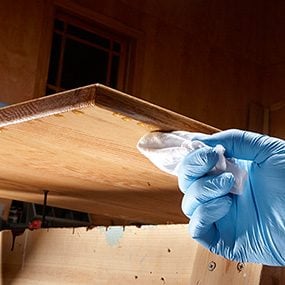
Never use wax or polish
- All you need for routine cleaning and care of your table is a damp cloth. When normal wear eventually dulls the finish, you can renew it in just a few minutes with another coat of wipe-on poly. But if you’ve ever used furniture wax or polish, a fresh coat of poly may not stick.
